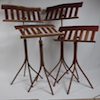I recently built a dining table for a client of mine and the top has developed some cracks. One area is even starting to buckle upwards slightly. Here are the facts:
1. The top is made up of (6) 4" wide flat-sawn white oak veneers 1/8" thick, glued (Titebond 3) to a 3/4" plywood base.
2. The top has a single finish coat of Rubio Monocoat.
3. Humidity in my shop is 40% (radiant floor heat). The client has forced-air, so I'm sure it's less than that.
4. The underside of the table has been sealed with polyurethane.
So I'm not sure if it's the Rubio Monocoat allowing the wood to dry out,that's the problem or maybe I should've use quarter-sawn white oak, or maybe the veneers were too thick or too wide and that is causing the issues.
Thoughts?




 Reply With Quote
Reply With Quote


